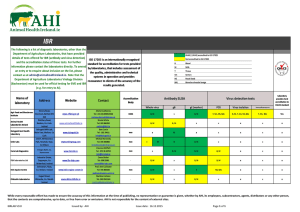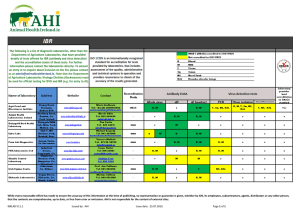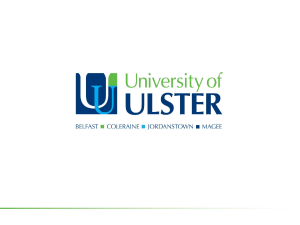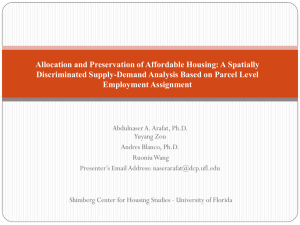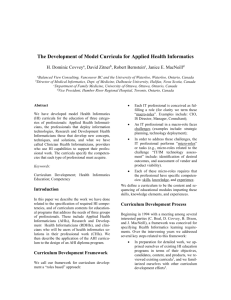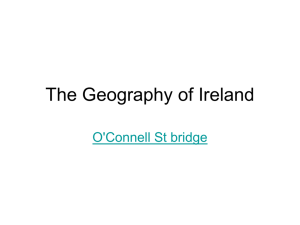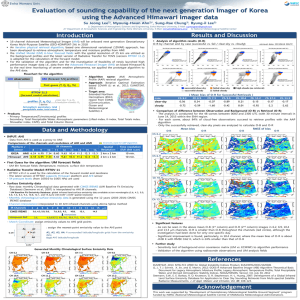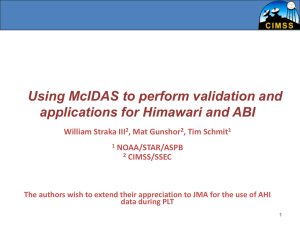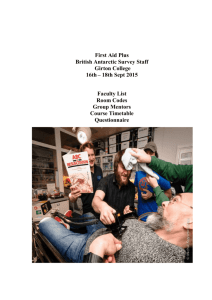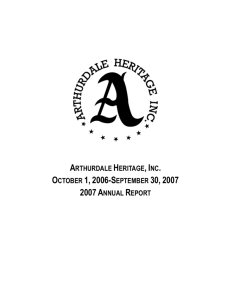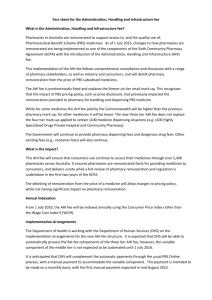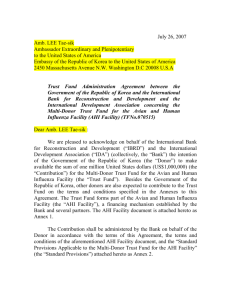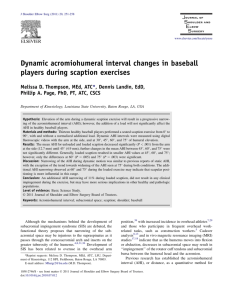Opening Statement Animal Health Ireland 310315
advertisement
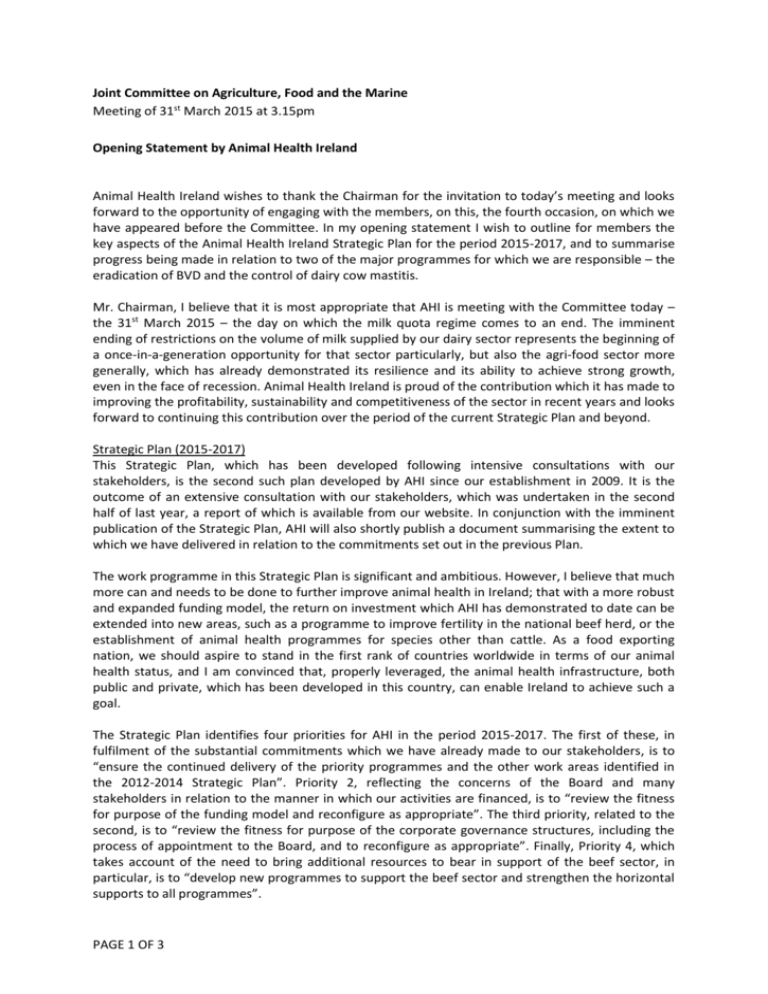
Joint Committee on Agriculture, Food and the Marine Meeting of 31st March 2015 at 3.15pm Opening Statement by Animal Health Ireland Animal Health Ireland wishes to thank the Chairman for the invitation to today’s meeting and looks forward to the opportunity of engaging with the members, on this, the fourth occasion, on which we have appeared before the Committee. In my opening statement I wish to outline for members the key aspects of the Animal Health Ireland Strategic Plan for the period 2015-2017, and to summarise progress being made in relation to two of the major programmes for which we are responsible – the eradication of BVD and the control of dairy cow mastitis. Mr. Chairman, I believe that it is most appropriate that AHI is meeting with the Committee today – the 31st March 2015 – the day on which the milk quota regime comes to an end. The imminent ending of restrictions on the volume of milk supplied by our dairy sector represents the beginning of a once-in-a-generation opportunity for that sector particularly, but also the agri-food sector more generally, which has already demonstrated its resilience and its ability to achieve strong growth, even in the face of recession. Animal Health Ireland is proud of the contribution which it has made to improving the profitability, sustainability and competitiveness of the sector in recent years and looks forward to continuing this contribution over the period of the current Strategic Plan and beyond. Strategic Plan (2015-2017) This Strategic Plan, which has been developed following intensive consultations with our stakeholders, is the second such plan developed by AHI since our establishment in 2009. It is the outcome of an extensive consultation with our stakeholders, which was undertaken in the second half of last year, a report of which is available from our website. In conjunction with the imminent publication of the Strategic Plan, AHI will also shortly publish a document summarising the extent to which we have delivered in relation to the commitments set out in the previous Plan. The work programme in this Strategic Plan is significant and ambitious. However, I believe that much more can and needs to be done to further improve animal health in Ireland; that with a more robust and expanded funding model, the return on investment which AHI has demonstrated to date can be extended into new areas, such as a programme to improve fertility in the national beef herd, or the establishment of animal health programmes for species other than cattle. As a food exporting nation, we should aspire to stand in the first rank of countries worldwide in terms of our animal health status, and I am convinced that, properly leveraged, the animal health infrastructure, both public and private, which has been developed in this country, can enable Ireland to achieve such a goal. The Strategic Plan identifies four priorities for AHI in the period 2015-2017. The first of these, in fulfilment of the substantial commitments which we have already made to our stakeholders, is to “ensure the continued delivery of the priority programmes and the other work areas identified in the 2012-2014 Strategic Plan”. Priority 2, reflecting the concerns of the Board and many stakeholders in relation to the manner in which our activities are financed, is to “review the fitness for purpose of the funding model and reconfigure as appropriate”. The third priority, related to the second, is to “review the fitness for purpose of the corporate governance structures, including the process of appointment to the Board, and to reconfigure as appropriate”. Finally, Priority 4, which takes account of the need to bring additional resources to bear in support of the beef sector, in particular, is to “develop new programmes to support the beef sector and strengthen the horizontal supports to all programmes”. PAGE 1 OF 3 While Priority 1 – the delivery of our existing core programmes – will be dealt with more substantively later in this opening statement, and will undoubtedly be the subject of further questions by members following the statement, I would like to outline some of the thinking behind the other three priorities articulated in the Strategic Plan. Priority 2 is to review the fitness for purpose of the funding model and reconfigure as appropriate. The Stakeholder consultation exercise highlighted that the current funding model, which is largely based on subscriptions provided by private sector organisations and the partial matching of these by the Department of Agriculture, Food and the Marine, is highly vulnerable to the loss or withdrawal of funding by individual stakeholders. The loss of even relatively modest amounts of stakeholder income, amplified by the consequent loss of matched Departmental funding, would have a dramatic impact on AHI’s ability to sustain current programmes and hence on the viability of the organisation itself. Concrete proposals for the development of a revised, sustainable funding model for Animal Health Ireland will be developed by the Board, in consultation with stakeholders. These proposals will be presented to Members, in conjunction with proposals on revised governance arrangements, at a Special General Meeting, which will take place in 2015. Priority 3 is to review the fitness for purpose of the corporate governance structures, including the process of appointment to the Board, and reconfigure as appropriate. Following consideration of the outcome of the Stakeholder consultation exercise, the Board of AHI has undertaken, in consultation with DAFM and other Members and stakeholders, to bring forward proposals aimed at further strengthening and ensuring the continued fitness for purpose of the corporate governance of the organisation. These proposals will establish the competencies and skills mix required of Directors, embody best practice in terms of corporate governance, bring greater transparency to the appointments process and provide a mechanism to allow for Members’ voices to be directly represented on the Board. A discussion document detailing the proposed new arrangements will be circulated to Members in the first half of 2015. The alterations to the Articles of Association required to give effect to the proposed changes will be presented to Members, in conjunction with proposals on revised funding arrangements, at a Special General Meeting, which will take place in 2015. Priority 4 is to develop new programmes to support the beef sector and strengthen the horizontal supports to all programmes. In this regard, AHI is pleased to be able to highlight to members the establishment of a new programme – Beef HealthCheck – which is being developed by AHI, Meat Industry Ireland and ICBF, in collaboration with the Department of Agriculture, Food and the Marine and Veterinary Ireland. The objectives of this programme are two-fold: to develop tools to assist farmers and their veterinary practitioners to control losses due to liver fluke and pneumonia through capture, analysis and reporting of abattoir data; and to contribute to the development by ICBF of economic breeding indexes that incorporate health and disease data. BVD The objective of this programme is to eradicate Bovine Viral Diarrhoea (BVD) from the national cattle herd by year end 2020. BVD is a disease of considerable economic importance to Irish farmers; a cost-benefit analysis commissioned by AHI places the losses associated with this infection at €102 million/annum. The compulsory phase of the programme, which began in 2013 following a successful pilot in 2012, is divided into two three-year periods. In the first of these, running from 2013-2015, the emphasis is on tissue tag testing of newborn calves, using the modified national identity tag, with follow-up testing by blood sample and tag testing, as required. The second period, running from 2016-2018, will see the emphasis switching to monitoring, by means of targeted blood and milk sampling, in addition to continued tag testing. The level of farmer engagement with the programme has been PAGE 2 OF 3 very strong, with in excess of 99% of all registered calves having been tested for BVD each year since the programme entered the compulsory phase. My colleague David Graham will be happy to take members through the details of the progress being made in this programme. However, to briefly summarise here; the incidence of PI calves has fallen by 31% from 0.67% (13,942) of all calves born in 2013 to 0.46% (9,762) in 2014. To date in 2015, the PI birth rate has fallen further to 0.30%. CellCheck The CellCheck programme is the national mastitis control programme, which is coordinated and facilitated by Animal Health Ireland, and which is being developed and delivered in partnership with industry bodies representing farmers, processors, service providers and government. The objective of the programme is to facilitate the Irish dairy industry to continue to improve milk quality, such that 75% of the milk supplied by Irish farmers will have an SCC of 200,000 cells/mL or less by year end 2020. High somatic cell counts (SCC), which are an indicator of mastitis, have a major impact on the profitability of dairy farmers and dairy processors. Teagasc research shows that there is a very significant inverse correlation between SCC and net farm profit. On the basis of this research, it can be stated that the average dairy farmer can improve net profitability by at least 1 cent per litre by improving mastitis control to reduce SCC to achievable and sustainable levels. Put another way, the research shows that a reduction from >400,000 to <100,000 cells/mL would lead to an increase in overall returns to farmer and processor together of 4.8 c/L. A 10% reduction in national cell count would be expected to yield €37.6 million savings for the Irish dairy industry. Again, my colleague Finola McCoy will be pleased to provide further details of this programme to members. However, I would like to highlight at this point that data from milk recording herds shows that the proportion of these with a SCC of less than 200,000 cells/mL, which had fluctuated between approximately 25% and 35% of all milk recording herds in the period 2004- 2010, has shown a marked improvement in the period since then, to stand at approximately 55% in 2014. Conclusion Mr. Chairman, I would like to take this opportunity to publicly acknowledge the steadfast support financial and otherwise - which we have received from our Members and stakeholders in the period since our establishment, and without which we would be unable to deliver on behalf of the industry. As CEO, I would also like to thank the Chairman of AHI and his fellow Directors, on whose on whose good counsel and guidance I have always been able to rely. Together with my colleagues, I look forward to engaging with members on any of the matters mentioned in this opening statement, and indeed on any other aspects of our work. ENDS PAGE 3 OF 3
